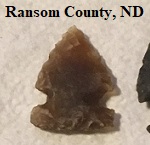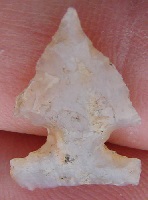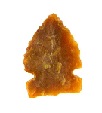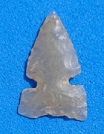Name Details:
Named By: Richard "Scotty" MacNeish
Named For:
Date Identified: 1954
Type Site: Stott Mound and Village
near Brandon, Manitoba, Canada
Plains Side Notch
Cluster: Plains Small Side Notch Cluster
Commonly Utilized Material:
A variety of locally available materials commonly heat
treated.
Date:
Cultural Period:
Glacial Period:
Culture:
700 - 200 B.P.
Developmental
Medieval Warm
Outline is Representative of Common Size and Shape:
Description of Physical Characteristics and Flaking Pattern:
This is a
thin small to medium ( 1 to 1.5 inch) point with an elliptical to flattened cross section. The blade may range from straight to excurvate. This point has high narrow parallel notches creating shoulders that are horizontal. The stem is expanded and usually wider than the blade. The base varies from straight to concaved and may have sharp basal ears. This point
is manufactured using pressure flaking forming a random flaking pattern and commonly has high quality flaking.
Size Measurements - Length - 10 to 34 mm (20.6
mm mean), Width - 9 to 18 mm (14.2 mm mean), Thickness - 2 to 7 mm (2.6 mm mean)
Distribution:
Distribution Comments:
This point is associated with nomadic bison hunters of the plains and prairie region. This point is found from the plains of Saskatchewan and Alberta into the Plains of
Montana, North and South Dakota. May be found into the plains region of Colorado, Nebraska and into Kansas.
The highest concentrations of these points are found in the southern
region of the plains suggesting a Mississippian cultural influence (Drager
and Ireland (1986)

Additional Comments:
Loyd Doty writes:
"PLAINS
SIDE NOTCH (True Arrowhead) – was defined by R.S. MacNeish, R. Forbis, and T. Kehoe. They are small (1 to 1.5”) projectile points that are characterized by
triangular well defined outlines with sharp angles at the bases and notches. Flaking is well executed and always bifacial. Notches are small, deep, and narrow, an acute U in shape and placed
fairly high on the blades. The bases
are often the same width, even wider than the proximal end of the blades. The corners of the bases and notches are square. Bases are straight or concave. Distribution includes (2nd map below) Canada, the northern tier of Plains States south to northeast
Colorado and northwest Kansas and they were in use during the Late
Prehistoric period. Reference: Kehoe, Thomas 1966:833, The
Small Side-notched Point System of the Northern Plains.
American Antiquity 31(6): 827-841. "
This point became the predominate point following the Prairie Side Notch.
Prairie Side-Notched is distinguished from Plains Side Notched points
largely by its less symmetrical shape and poorer workmanship while Plains
Side Notch points have a defined outline with sharp angular base and notches
and blades with a straight edge which is rarely serrated (Kehoe 1966).
This type was re-defined by Kehoe in 1966. He identified 7 variants of the Plains Side Notch point.
Plains Side Notch variants as described by Kehoe (as illustrated 1966)
 1. Plains Side Notch (Primary type) 2. Billings, 3. Buffalo Gap, 4. Cut Bank, 5. Emigrant, 6. Paskapoo, 7. Pekisko, 8. Washita
1. Plains Side Notch (Primary type) 2. Billings, 3. Buffalo Gap, 4. Cut Bank, 5. Emigrant, 6. Paskapoo, 7. Pekisko, 8. Washita
References: (See Reference Page, Entry Number):
23, 30, 36, 79, 168, 176, W2, W8
Other points in this Cluster:
Point Validity: Valid Type
MacNeish was a pioneering anthropologist who was most notable for his excavations and studies at Tamaulipas Mexico. This type has been references in professional
publications and is considered a valid type.
Age Details:
This point is associated with the One Gun Phase of Alberta, Saskatchewan, and into Montana.
Plains Side Notch Projectile Point, Plains Side Notch Arrowhead

 1. Plains Side Notch (Primary type) 2. Billings, 3. Buffalo Gap, 4. Cut Bank, 5. Emigrant, 6. Paskapoo, 7. Pekisko, 8. Washita
1. Plains Side Notch (Primary type) 2. Billings, 3. Buffalo Gap, 4. Cut Bank, 5. Emigrant, 6. Paskapoo, 7. Pekisko, 8. Washita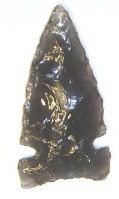
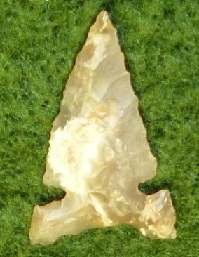


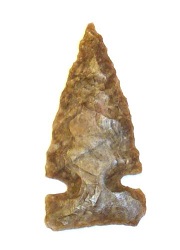
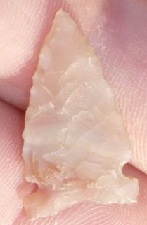
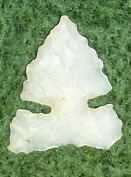
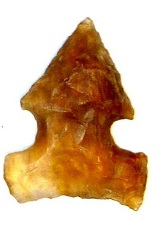
.jpg)
